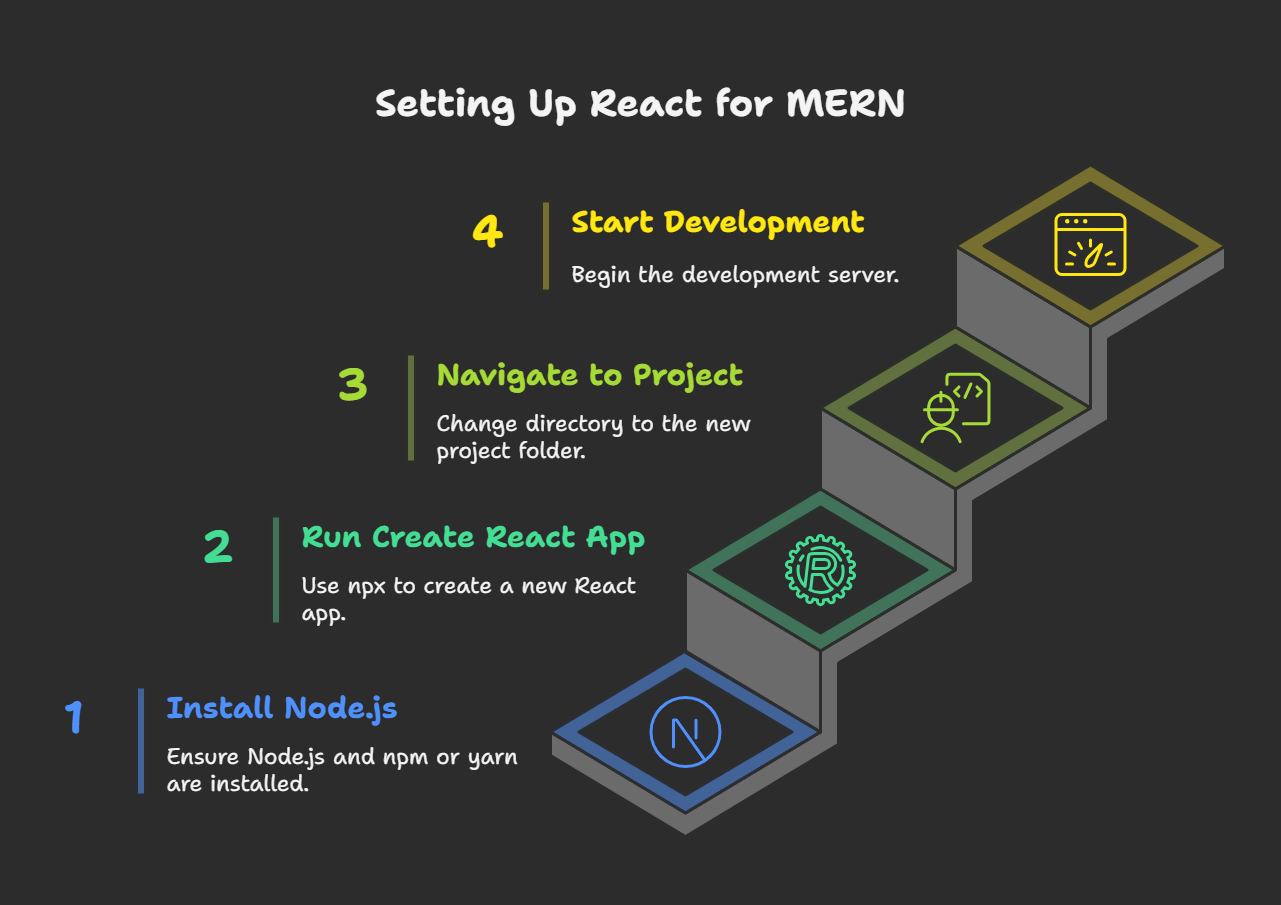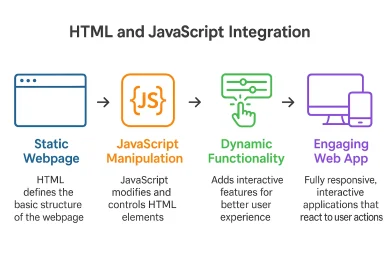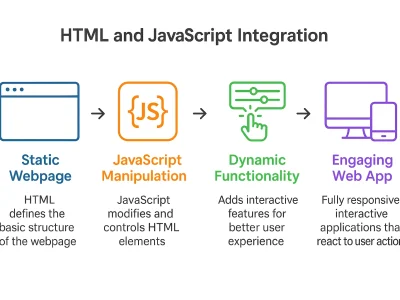Introduction
Do you want to develop progressive, user-friendly web-based applications? Well, the MERN stack (a Java script that includes four technologies, namely MongoDB, Express, React.js, and Node.j,s and is typically used for faster deployment of web-based applications) is a powerful combination for developing and dispensing your web applications.
It is generally considered that React.js is the nucleus of the MERN stack and is used for front-end development. React.js is a component-oriented Javascript library used to develop User Interfaces (UI), which allows developers to create reusable UI elements and strategically manage the dynamic features of web applications. What is the importance of React.js, and why is it the most preferred choice of MERN stack developers?
This blog post analyses the elements of React.js and explores its features concerning the MERN stack and its benefits for full-stack application development. Further, we will discover how React’s component-oriented framework, virtual DOM (Document Object Model), and other features make it the most preferred tool for developing contemporary, efficient web experiences for users. Whether you are a fresher or an experienced developer willing to upgrade your skill set, this blog and our course will help you master MERN stack development.
Setting Up a React.js Project for MERN Stack Development
At the outset, setting up a React.js project forms the foundation of MERN stack development. The first step includes installing React.js using the Create React application, which also provides a structured project template for development. While installing React.js, it is important to note down the following:
- Ensure that you have Node.js and npm or yarn installed (you can download them through the Node.js official website as a bundle)
- Open the terminal, select the project directory option, and run – “npx-create-react-app my-mern-app” (replace mern-app with the project name)
- Navigate to your project “cd-my-mern-app” and
- Begin your development process- “npm start”.
It is preliminarily important to thoroughly understand the project structure to initiate development. Generally, the client directory includes the React.js frontend, including folders such as src (for code) and public (for fixed assets). The src directory also organizes components, generally within components and other essential files.
Typically, the best practices to strategically organize components and files include using descriptive names and codes, using a consistent folder structure, and ensuring all components are small and clear. A strategically managed project upholds the objectives of development, i.e. scalability, maintainability, and collaboration, making it a smooth journey to scale and manage the application.
Core React.js Concepts for MERN Stack Developers
The concepts of Core React.js are primary to master MERN stack development. JSX (JavaScript XML) tends to simplify writing HTML-like structures in JavaScript and focuses on readability. Virtual DOM, on the other hand, maximises application performance by diminishing direct DOM-oriented updates. Strategic management of component state (data within a specific component) and props (data passed on to specific components) is highly important for developing contemporary UIs.
A thorough understanding of React.js components’ lifecycle and hooks helps you to effectively control the inherent nature of components and effectively manage the side effects. These core concepts form the cornerstone of MERN stack development.
Implementing Routing in React.js for MERN Stack Applications
Routing, in web development, is the procedure to analyze which content to be displayed when any user navigates to a specific URL. In layman’s terms, it is like a map that directs users to different pages or sections on your website. This typically includes URLs, routes, and the actual content to be displayed. In single-page applications developed with React.js, routing is generally initiated on the client side, creating an uninterrupted user experience.
React Router is the go-to library for incorporating client-side navigation and allows you to pre-define routes, integrate URLs with respective components, and allow smooth transitions between respective views without complete page reloads. Setting up variable and enclosed routes is appropriate for complex navigation frameworks while tackling secured routes enables authentication-based access. It is important for MERN stack developers to master the concept of routing for building dynamic web-based applications.
State Management in React.js for Scalable MERN Stack Applications
Data management is vital in developing scalable MERN stack web applications with React.js. Choosing the appropriate state management approach is crucial for smooth development. Context API is usually used for smaller applications, while Redux is essential for managing application-wide data efficiently for larger projects. Redux offers a centralized data mine and predictable data updates while simplifying complex data flows.
Moreover, tackling API responses and data synchronization in React.js is crucial and includes managing incongruous requests, consistent data updates based on API responses, and, most importantly, data consistency across all elements. A proactive approach in state management and real-time synchronization is the key to high-performance and maintainable MERN stack applications.
How to Connect React.js with Express.js and MongoDB
Connecting React.js frontend to Express.js and MongoDB backend forms the backbone of MERN stack development. This connection is created by making API requests from React.js to the Express.js backend. Libraries such as fetch/axios facilitate these requests and enable defined communication with API endpoints. Further, Express.js establishes communication with MongoDB to handle data fetching and CRUD (Create, Read, Update, and Delete) operations.
Express.js acts as an intermediary to receive requests from react.js and interact with MongoDB to retrieve and manipulate data. Furthermore, displaying of live updates in React elements can be attained using technologies like WebSockets (which establishes a consistent connection between the client and server that provides instant updates without repeated requests for data) and Server-sent events, which facilitates the serves to push real-time updates to the clients. These connections are vital in developing data-centric MERN stack applications for a distinguished user experience.
Implementing User Authentication & Security in React.js for MERN Stack
User Authentication and Security measures are the key to building high-performance MERN stack applications. Secured authentication using JWT (JSON Web Tokens) is paramount in contemporary web development projects, thereby enabling traditional authentication and protected API access. Strategic session management and secured routes within the react.js application ensure authorized access to confidential data and functionality for selective users only. Prioritizing adherence to best security practices is essential in MERN stack development.
These practices include a reduction in vulnerabilities, i.e. cross-site scripting (XSS) and cross-site request forgery (CSRF) attacks, and proactively safeguarding confidential data. Proactive implementation of these security measures helps in building flexible and dynamic web applications.
Optimising React.js Performance in MERN Stack Applications
Optimizing the performance of any technology stack is important to enhance user experience. Similarly, upgrading React’s performance is essential to facilitate a smooth user experience in MERN stack applications. Several performance enhancement techniques can be deployed in React, i.e. Reducing the bundle size through code splitting (divides your application into small, on-demand blocks) and lazy loading (impedes component loading until required using dynamic imports and fallbacks), which speeds up the initial load times.
Further, memorization techniques such as React. Memo and useMemo defer irrelevant relinquishment of components, thereby optimizing efficiency. Moreover, API calls and component updates are vital as well. The use of techniques such as caching, pagination, and debouncing is important to reduce network requests and maximize data fetching. By efficiently incorporating these best practices, one can create high-performance React.js applications within the MERN stack.
Deploying a MERN Stack Application with React.js
Deploying a MERN stack application is as critical as developing it. The procedure is divided into several key steps, including-
- Firstly, it is important to prepare the React.js frontend for production, i.e. optimizing the code, compressing the javascript and images, and bundling applications using tools. This helps to create a production-ready version of your front-end development.
- Secondly, it is crucial to connect the frontend and backend in a live environment which requires setting up API (Application Programming Interface) endpoints on the Express.js backend through which the React application can communicate.
- Confidentially secure environment variables for sensitive information such as API keys.
- Incorporate authentication and authorization protocols.
- Lastly, select an appropriate deployment platform. It is important to consider the ideal use and consider factors such as cost, scalability, etc.
For instance, Nelify is the most preferred option for static websites and offers Git integration; Vercel is suitable for smooth deployments and performance and is ideal for frontends; and Heroku is a PaaS platform that offers an end-to-end ecosystem for MERN stack and promotes scalability.
Conclusion
React.js has an inherent characteristic that can change your design and web development perspective. It promotes an element-based approach wherein one can break down the UI components into pieces. Further, one can describe these elements and convert them to reusable components. Finally, these pieces are connected through which the data flows. Through this blog post, we have covered the essentials of React.js for MERN stack development to help you modernize your web development career. The key takeaways include but are not limited to Understanding React’s element-based framework, reusability, efficient file management, and adhering to the best development practices, which are essential for developing scalable MERN stack web applications.
What’s next for your full-stack MERN developer journey? Explore the advanced concepts and features of React.js and dive deeper into the backend technologies of the MERN stack, i.e. MongoDB, Express.js, and Node.js. Lastly, develop real-world projects basis your learnings and strengthen your experience.
Are you ready to become a full-stack developer? Enroll in our MERN stack development course and build real-time projects!
Did you find this blog post helpful? Bookmark it for future use and share it with your fellow learners.





